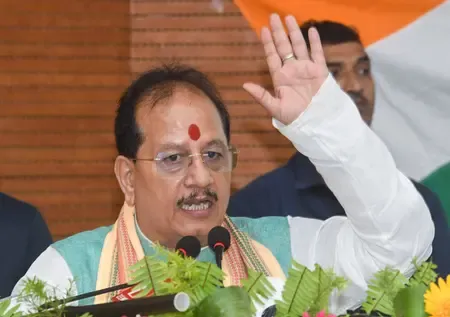Is the Indian Economy 'Steady as She Goes' in FY26 with Resilient Q1 Growth?

Synopsis
Key Takeaways
- Resilient domestic demand driving economic growth.
- Inflation remains within target range.
- Projected GDP growth between 6.2% and 6.5%.
- Banking sector shows strong health with low GNPA and NNPA ratios.
- Favorable monsoon conditions boosting agriculture.
New Delhi, July 28 (NationPress) The initial quarter of FY26 showcases a strong foundation of domestic supply and demand dynamics. With inflation staying within the targeted parameters and favorable monsoon developments, the domestic economy is transitioning into the second quarter of FY26 on a solid basis, as highlighted in the Finance Ministry's 'Monthly Economic Review for June 2025' released on Monday. The report emphasized that the economy exhibits a sense of "steady as she goes" for the current fiscal year (FY26).
India's macroeconomic indicators remain robust, driven by vigorous domestic demand, fiscal discipline, and monetary backing. The nation is on track to maintain its status as one of the fastest-growing major economies, with various analysts, including S&P, ICRA, and the RBI's Survey of Professional Forecasters, estimating GDP growth rates for FY26 in the range of 6.2 percent to 6.5 percent.
The financial markets in India have shown remarkable resilience, primarily fueled by strong participation from domestic investors. This robustness is further supported by the solid health of the banking sector, where banks have successfully reinforced their capital and liquidity positions while enhancing asset quality.
The report indicated, "The GNPA and NNPA ratios of scheduled commercial banks stand at a multi-decade low of 2.3 percent and 0.5 percent, respectively, alongside impressive earnings.
Q1 FY26 witnessed economic activities bolstered by strong domestic demand, significant growth in services, and positive trends in manufacturing and agriculture.
Agricultural performance received a substantial boost from an early southwest monsoon, which has thus far provided above-average rainfall. The availability of fertilizers and reservoir levels are above normal, indicating a promising outlook for kharif sowing and harvest, thereby enhancing rural income and demand.
The agricultural sector's consistent performance acts as a stabilizing force for the broader economy and strengthens the rural outlook. According to NABARD's rural sentiment survey, over 74.7 percent of rural households anticipate income growth in the forthcoming year, marking the highest expectations since the survey began.
The Economic Review further conveyed a sense of cautious optimism regarding the Indian economy in mid-2025.
Despite geopolitical tensions remaining stable, a global slowdown—especially in the US, which contracted by 0.5 percent in Q1 2025—could potentially dampen demand for Indian exports. Ongoing uncertainty surrounding US tariffs may also affect India's trade performance in the upcoming quarters. Additionally, sluggish credit growth and a lack of private investment appetite could hinder economic momentum, as noted in the report.
The report concluded, "In the medium term, with significant shifts occurring in global supply chains regarding semiconductor chips, rare earths, and magnets, India faces considerable challenges ahead."









